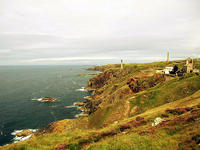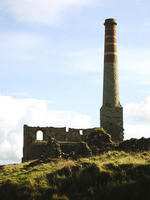You are in: Europe -> United Kingdom. England -> Cornwall and West De... , and traditional search or Image Gallery will yield results of this site only
Cornwall and West Devon Mining Landscape
| Site number: | 1215 |
|
| Type of site: | Cultural | |
| Date: | 18-19th-century | |
| Date of Inscription: | 2006 | |
| Location: | Europe, United Kingdom of Great Britain and Northern Ireland, Cornwall and Devon Counties | |
Up to 75 images are shown here. Click on each for more details or on Image Gallery for more images.
| Description: | Much of Cornwall’s and West Devon’s landscape was transformed in the 18th and early 19th centuries in consequence of the rapid escalation of ground-breaking copper and tin mining. Collectively its cavernous underground mines, engine houses, foundries, new towns, smallholdings, ports and harbours, and their ancillary industries reveal abundant innovation which allowed the region, in the early 19th century, to produce two-thirds of the world’s supply of copper. The extensive remains testify to Cornwall’s and West Devon’s role in the Industrial Revolution in the rest of Britain and to the deep influence the area held on the mining world in general. Embodied in engines, engine houses and mining equipment, Cornish technology was exported around the globe. From Cornwall and West Devon as the origin, mining technology rapidly spread further afield. --WHMNet paraphrase from the description at WHC Site, where additional information is available. | |
| The Cornwall and West Devon Mining Landscape is a World Heritage Site which includes select mining landscapes across Cornwall and west Devon in the south west of the United Kingdom. The Site was added to the World Heritage List during the 30th Session of the UNESCO World Heritage Committee in Vilnius, July 2006. The landscapes of Cornwall and west Devon were radically reshaped during the eighteenth and nineteenth centuries by deep-lode mining for copper and tin. The underground mines, engine houses, foundries, new towns, smallholdings, ports, harbours, and ancillary industries together reflect prolific innovation which, in the early nineteenth century, enabled the region to produce two-thirds of the world's supply of copper. During the late 1800s, arsenic production came into ascendancy with mines in the east of Cornwall and west Devon supplying half the world’s demand. The early nineteenth century also saw a revolution in steam technology which was to radically transform hard-rock mining fortunes. The high-pressure expansively operated beam pumping engine developed by the engineer Richard Trevithick enabled mining at much greater depths than had been possible hitherto. Cornish-design beam engines and other mining machinery was to be exported from major engineering foundries in Hayle, Perranarworthal, Tavistock and elsewhere to mining fields around the world throughout the century. Commencing in the early 1800s, significant numbers of mine workers migrated to live and work in mining communities based on Cornish traditions, this flow reaching its zenith at the end of the nineteenth century. Today numerous migrant-descended Cornish communities flourish around the world and distinctive Cornish-design engine houses can be seen in Australia, New Zealand, South Africa, Mexico, the British Virgin Islands, Spain, and in the mining fields of England, Wales, Scotland, Ireland, the Channel Islands, and the Isle of Man. A much reduced mining industry continued in Cornwall after the copper crash of the 1860s with production mainly focused on tin. Metalliferous mining finally ceased in Cornwall in 1998 with the closure of South Crofty Mine, Pool, the last tin mine to operate in Europe. --Wikipedia. Text is available under the Creative Commons Attribution-ShareAlike License. | ||
| Source: | http://whc.unesco.org/en/list/1215 | |
| Reference: | 1. UNESCO World Heritage Center, Site Page. | |







































